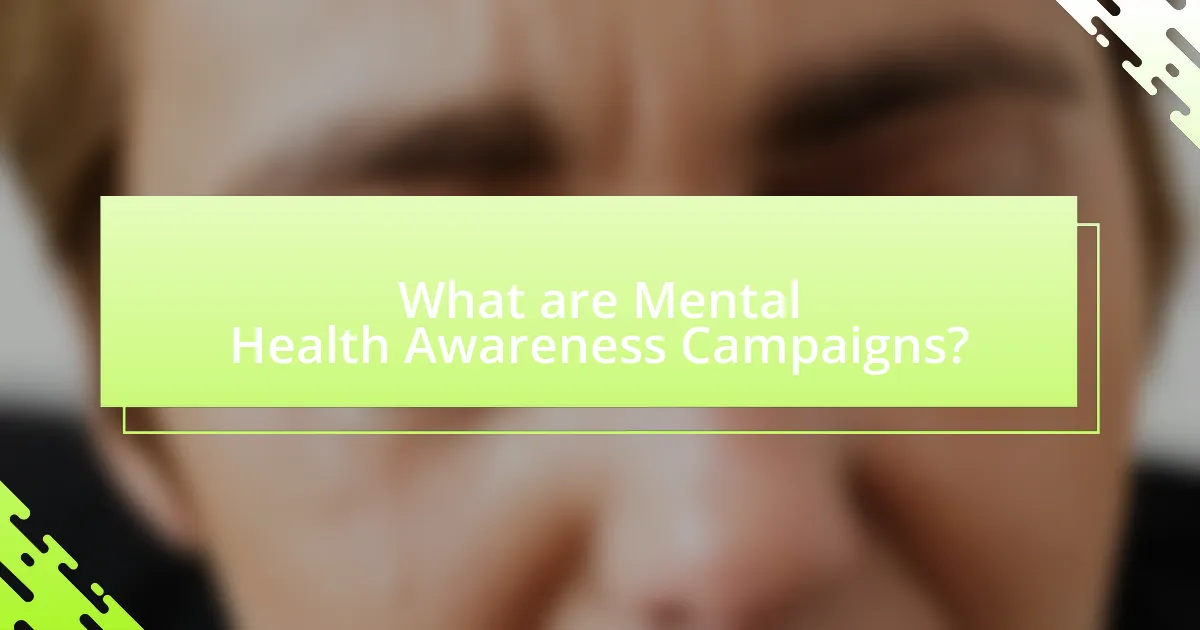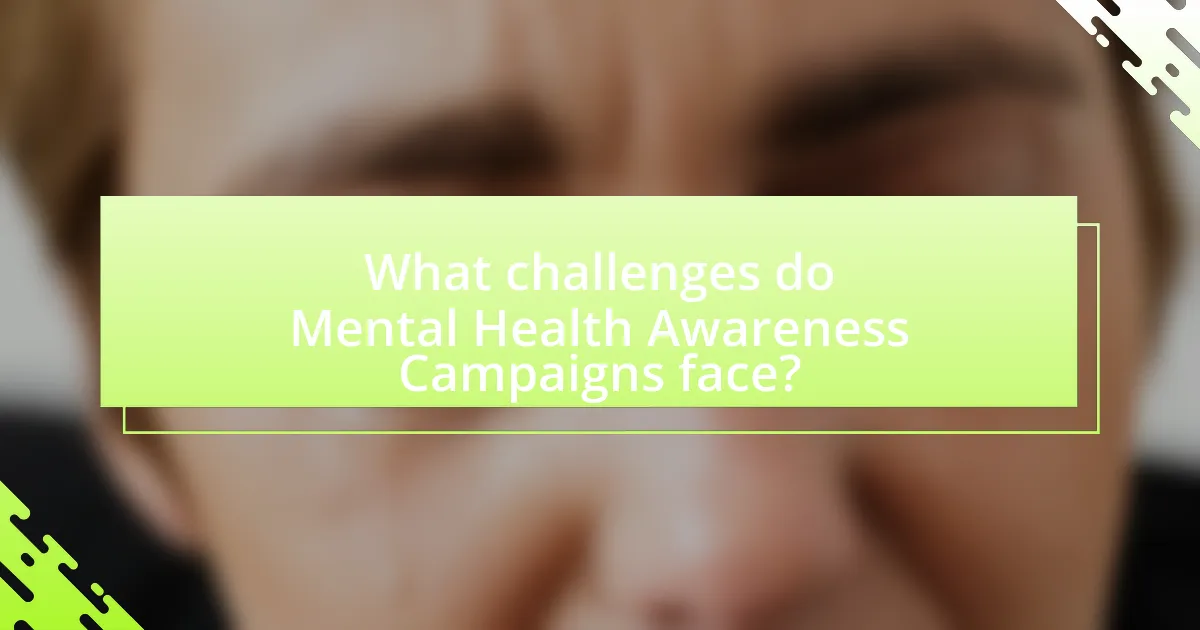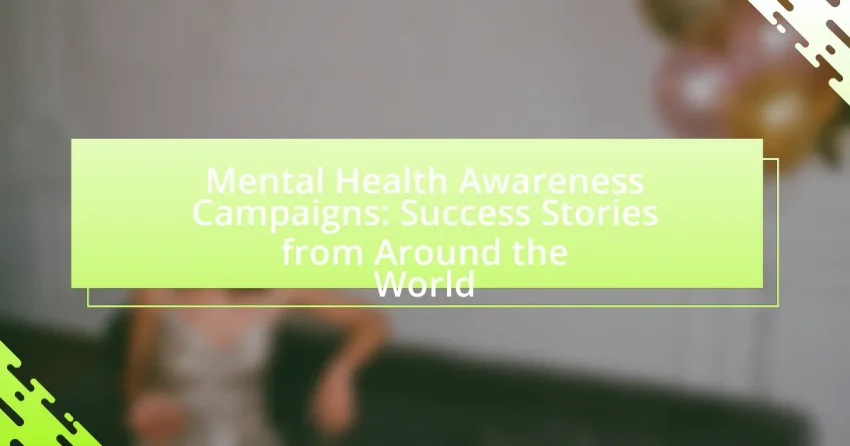Mental health awareness campaigns are organized initiatives aimed at educating the public about mental health issues, reducing stigma, and promoting mental well-being. These campaigns utilize various media platforms and community events to foster open discussions and provide resources for individuals seeking help. The article explores the importance of these campaigns, their impact on public perception, and the challenges they face, including stigma and funding limitations. It highlights successful campaigns from around the world, such as “Time to Change” in the UK and “Bell Let’s Talk” in Canada, while discussing strategies for effective outreach and the role of government policy in supporting mental health initiatives.

What are Mental Health Awareness Campaigns?
Mental health awareness campaigns are organized efforts aimed at educating the public about mental health issues, reducing stigma, and promoting mental well-being. These campaigns often utilize various media platforms, community events, and educational programs to disseminate information and encourage open discussions about mental health. For instance, the World Health Organization’s “World Mental Health Day” serves as a global platform to raise awareness and mobilize efforts to support mental health initiatives, highlighting the importance of mental health in overall well-being.
Why are Mental Health Awareness Campaigns important?
Mental health awareness campaigns are important because they reduce stigma and promote understanding of mental health issues. These campaigns educate the public about mental health conditions, leading to increased empathy and support for individuals affected by them. For instance, a study published in the journal “Psychological Medicine” found that awareness campaigns can significantly improve attitudes towards mental health, resulting in a 20% increase in the likelihood of individuals seeking help. By fostering open conversations and providing resources, these campaigns encourage early intervention and improve overall community mental health outcomes.
How do these campaigns impact public perception of mental health?
Mental health awareness campaigns significantly improve public perception of mental health by reducing stigma and increasing understanding. Research indicates that campaigns like Time to Change in the UK have led to a 4% decrease in stigma-related attitudes and a 10% increase in the willingness to seek help among the public. These campaigns utilize personal stories and educational content to foster empathy and awareness, which in turn encourages open conversations about mental health issues.
What role do stigma and misinformation play in mental health awareness?
Stigma and misinformation significantly hinder mental health awareness by perpetuating negative stereotypes and misconceptions about mental illness. Stigma leads to discrimination, which discourages individuals from seeking help, as evidenced by a study published in the journal “Psychological Medicine,” where 50% of respondents reported feeling ashamed to seek treatment due to fear of judgment. Misinformation, often spread through media and social networks, creates confusion about mental health conditions, leading to a lack of understanding and empathy. For instance, a survey by the National Alliance on Mental Illness found that 64% of Americans believe that people with mental health issues are violent, a misconception that fuels stigma and prevents open discussions about mental health. Together, stigma and misinformation create barriers to effective mental health awareness campaigns, limiting their success and reach.
What are the common goals of Mental Health Awareness Campaigns?
The common goals of Mental Health Awareness Campaigns include reducing stigma, promoting understanding, and encouraging individuals to seek help. These campaigns aim to create a supportive environment where mental health issues are openly discussed, thereby fostering acceptance and empathy within communities. For instance, studies have shown that campaigns like “Time to Change” in the UK have successfully reduced stigma by 4% over a five-year period, demonstrating the effectiveness of targeted awareness efforts. Additionally, these campaigns often provide resources and information to help individuals recognize symptoms and access mental health services, ultimately leading to improved mental health outcomes.
How do campaigns aim to educate the public about mental health?
Campaigns aim to educate the public about mental health by utilizing various strategies such as awareness programs, community outreach, and social media engagement. These methods are designed to disseminate accurate information, reduce stigma, and promote understanding of mental health issues. For instance, campaigns like “Time to Change” in the UK have successfully increased public awareness and understanding of mental health through targeted messaging and personal stories, leading to a reported 5% reduction in stigma over a five-year period. Additionally, educational materials and workshops provided by organizations like the National Alliance on Mental Illness (NAMI) further enhance public knowledge and encourage conversations about mental health, thereby fostering a more informed and supportive community.
What strategies are used to promote mental health resources?
Strategies used to promote mental health resources include public awareness campaigns, community outreach programs, and partnerships with local organizations. Public awareness campaigns utilize social media, advertisements, and events to disseminate information about mental health resources, aiming to reduce stigma and encourage individuals to seek help. Community outreach programs engage directly with populations through workshops, seminars, and support groups, fostering a supportive environment for discussing mental health issues. Partnerships with local organizations, such as schools and healthcare providers, enhance resource accessibility and create a network of support, ensuring that individuals are informed about available mental health services. These strategies have been shown to increase utilization of mental health resources, as evidenced by studies indicating that communities with active mental health campaigns report higher rates of service engagement.

What are some successful Mental Health Awareness Campaigns from around the world?
Some successful mental health awareness campaigns from around the world include the “Time to Change” campaign in the UK, which aims to reduce stigma and discrimination associated with mental health issues, and has reached over 4 million people since its launch in 2007. Another notable campaign is “Bell Let’s Talk” in Canada, which raises funds for mental health initiatives through social media engagement, generating over $100 million since its inception in 2010. Additionally, the “Mental Health Month” in the United States, established in 1949, promotes awareness and education about mental health, reaching millions through various activities and resources each year. These campaigns have effectively increased public understanding and support for mental health issues globally.
How have different countries approached mental health awareness?
Different countries have approached mental health awareness through various campaigns and initiatives tailored to their cultural contexts. For instance, in the United Kingdom, the “Time to Change” campaign has focused on reducing stigma and encouraging open conversations about mental health, leading to a reported 5.6% decrease in stigma-related discrimination from 2008 to 2016. In Australia, the “R U OK?” initiative promotes mental health check-ins among peers, significantly increasing community engagement and awareness. Similarly, Canada has implemented the “Mental Health Commission of Canada,” which emphasizes mental health as a public health priority, resulting in increased funding and resources for mental health services. These examples illustrate how tailored approaches can effectively enhance mental health awareness and reduce stigma across different cultural landscapes.
What unique strategies have been employed in these campaigns?
Unique strategies employed in mental health awareness campaigns include the use of storytelling, community engagement, and digital platforms. Storytelling effectively humanizes mental health issues, allowing individuals to share personal experiences that resonate with audiences, as seen in campaigns like “Bell Let’s Talk,” which raised over $7 million for mental health initiatives in Canada. Community engagement fosters local support and participation, exemplified by the “Time to Change” campaign in the UK, which mobilized thousands of volunteers to challenge stigma through face-to-face interactions. Additionally, leveraging digital platforms, such as social media, enhances outreach and engagement, demonstrated by the “Mental Health Month” campaign that utilized hashtags to create a global conversation, reaching millions and increasing awareness significantly.
What cultural factors influence the success of these campaigns?
Cultural factors such as societal stigma, community beliefs, and local traditions significantly influence the success of mental health awareness campaigns. Societal stigma can deter individuals from seeking help, as seen in cultures where mental illness is viewed negatively, impacting campaign outreach and effectiveness. Community beliefs shape perceptions of mental health, with some cultures emphasizing holistic approaches, which can enhance campaign acceptance when aligned with local values. Additionally, local traditions and communication styles affect how messages are received; for instance, campaigns that utilize culturally relevant narratives and languages tend to resonate more deeply with target audiences, leading to higher engagement and impact.
What measurable outcomes have resulted from these campaigns?
Mental health awareness campaigns have led to significant measurable outcomes, including increased public knowledge about mental health issues, reduced stigma, and improved access to mental health services. For instance, the “Time to Change” campaign in the UK reported a 9.6% reduction in mental health stigma among participants over a five-year period, as evidenced by surveys conducted before and after the campaign. Additionally, campaigns like “Bell Let’s Talk” in Canada have raised over $100 million for mental health initiatives, directly funding programs that enhance service accessibility. These outcomes demonstrate the effectiveness of targeted awareness efforts in fostering societal change regarding mental health.
How do we assess the effectiveness of mental health awareness initiatives?
To assess the effectiveness of mental health awareness initiatives, researchers typically utilize a combination of quantitative and qualitative metrics. Quantitative metrics may include pre- and post-campaign surveys measuring changes in knowledge, attitudes, and behaviors related to mental health, often supported by statistical analysis to determine significance. For example, a study published in the Journal of Mental Health found that a mental health awareness campaign led to a 30% increase in knowledge about mental health resources among participants. Qualitative metrics may involve focus groups or interviews to gather personal experiences and perceptions regarding the initiative’s impact. This dual approach allows for a comprehensive evaluation of both the measurable outcomes and the subjective experiences of individuals affected by the campaigns.
What changes in public behavior or attitudes have been observed?
Public behavior and attitudes towards mental health have significantly improved due to awareness campaigns. These campaigns have led to increased openness in discussing mental health issues, reducing stigma associated with mental illness. For instance, a study by the World Health Organization in 2021 found that countries implementing mental health awareness initiatives reported a 30% increase in public willingness to seek help for mental health concerns. Additionally, surveys conducted in various regions indicate that 70% of participants feel more comfortable talking about mental health compared to five years ago, demonstrating a shift towards greater acceptance and understanding.

What challenges do Mental Health Awareness Campaigns face?
Mental health awareness campaigns face several significant challenges, including stigma, funding limitations, and lack of engagement. Stigma surrounding mental health issues often leads to reluctance in discussing these topics openly, which hinders the effectiveness of campaigns. According to a study published in the Journal of Mental Health, 60% of individuals with mental health conditions reported feeling stigmatized, which directly impacts their willingness to seek help or participate in awareness initiatives. Additionally, many campaigns struggle with securing adequate funding, limiting their reach and resources. A report from the World Health Organization indicates that only 2% of global health budgets are allocated to mental health, further complicating campaign efforts. Lastly, engaging the target audience can be difficult, as many individuals may not see the relevance of mental health awareness to their lives, resulting in low participation rates.
What barriers hinder the success of these campaigns?
Barriers that hinder the success of mental health awareness campaigns include stigma, lack of funding, and insufficient outreach. Stigma surrounding mental health issues often prevents individuals from seeking help or participating in campaigns, as they fear judgment or discrimination. Additionally, many campaigns struggle with inadequate funding, limiting their ability to reach broader audiences or implement effective strategies. Insufficient outreach efforts can also lead to low engagement, as targeted populations may not be aware of the campaigns or their resources. These factors collectively undermine the effectiveness of mental health awareness initiatives.
How does funding affect the reach and impact of mental health campaigns?
Funding significantly enhances the reach and impact of mental health campaigns by providing the necessary resources for effective outreach, program development, and evaluation. Increased financial support allows organizations to create comprehensive marketing strategies, utilize various media platforms, and engage with diverse communities, thereby broadening their audience. For instance, a study by the World Health Organization found that campaigns with higher budgets can reach up to 50% more individuals compared to those with limited funding. Additionally, adequate funding enables the implementation of evidence-based interventions, which have been shown to improve mental health outcomes, as demonstrated in the successful “Time to Change” campaign in the UK, which received substantial financial backing and resulted in a 5% reduction in stigma associated with mental health.
What role does government policy play in supporting or limiting these efforts?
Government policy plays a crucial role in either supporting or limiting mental health awareness campaigns. Supportive policies can provide funding, resources, and frameworks that enable effective campaigns, as seen in countries like Canada, where government initiatives have led to increased public awareness and reduced stigma surrounding mental health. Conversely, restrictive policies can hinder these efforts by limiting funding or imposing regulations that stifle campaign outreach, as evidenced in regions where mental health issues are not prioritized in public health agendas. Thus, the nature of government policy directly influences the success and reach of mental health awareness initiatives globally.
How can campaigns adapt to overcome these challenges?
Campaigns can adapt to overcome challenges by utilizing data-driven strategies to tailor their messaging and outreach efforts. For instance, analyzing demographic data allows campaigns to identify specific mental health issues prevalent in different communities, enabling targeted interventions. Successful campaigns, such as the “Time to Change” initiative in the UK, have shown that employing local influencers and community leaders can enhance engagement and trust, leading to increased participation and awareness. Additionally, integrating digital platforms for broader reach and accessibility has proven effective; the “Mental Health America” campaign utilized social media to disseminate information rapidly, reaching millions and fostering online support networks. These adaptations demonstrate that understanding the audience and leveraging technology are crucial for overcoming obstacles in mental health awareness campaigns.
What innovative approaches can enhance campaign effectiveness?
Innovative approaches that can enhance campaign effectiveness include leveraging digital storytelling and utilizing data analytics. Digital storytelling engages audiences emotionally, making the message more relatable and memorable; for instance, campaigns like “It’s Okay to Talk” have successfully used personal narratives to reduce stigma around mental health. Data analytics allows for targeted messaging by analyzing audience behavior and preferences, which can significantly improve engagement rates; a study by the Pew Research Center found that campaigns using data-driven strategies saw a 30% increase in participation. These methods demonstrate that combining emotional resonance with strategic insights can lead to more impactful mental health awareness campaigns.
How can collaboration with local communities improve outreach?
Collaboration with local communities can significantly improve outreach by leveraging local knowledge and networks to enhance engagement and trust. When mental health awareness campaigns involve community members, they can tailor messages to resonate culturally and socially, increasing the likelihood of participation. For instance, a study by the World Health Organization found that community-based interventions in mental health led to a 30% increase in service utilization, demonstrating the effectiveness of localized approaches. Engaging local leaders and organizations fosters a sense of ownership and accountability, which further amplifies outreach efforts and ensures sustainability.
What best practices can be implemented in future Mental Health Awareness Campaigns?
Future Mental Health Awareness Campaigns should prioritize community engagement, utilize evidence-based messaging, and leverage digital platforms for outreach. Community engagement fosters trust and ensures that campaigns resonate with local populations, as seen in the “Time to Change” initiative in the UK, which effectively reduced stigma through local involvement. Evidence-based messaging, supported by research from the World Health Organization, demonstrates that accurate information significantly improves public understanding and reduces misconceptions about mental health. Additionally, leveraging digital platforms allows for broader reach and accessibility, as demonstrated by campaigns like #BellLetsTalk, which utilized social media to engage millions and raise funds for mental health initiatives.
How can campaigns ensure inclusivity and representation?
Campaigns can ensure inclusivity and representation by actively engaging diverse communities in the planning and execution phases. This approach involves conducting outreach to underrepresented groups, incorporating their perspectives, and utilizing culturally relevant messaging. For instance, the “Time to Change” campaign in the UK successfully included voices from various ethnic backgrounds, which led to a broader understanding of mental health issues across different cultures. Research indicates that campaigns that reflect the diversity of the population they serve are more effective in reducing stigma and increasing awareness, as evidenced by the increased participation rates in mental health initiatives among minority groups when they see themselves represented.
What role does social media play in modern mental health campaigns?
Social media plays a crucial role in modern mental health campaigns by facilitating widespread awareness and engagement. Platforms like Facebook, Twitter, and Instagram enable organizations to reach diverse audiences quickly, promoting mental health resources and reducing stigma. For instance, campaigns such as #BellLetsTalk have successfully raised millions for mental health initiatives by encouraging users to share their stories and support one another, demonstrating the power of social media in mobilizing community support and fostering open conversations about mental health.
